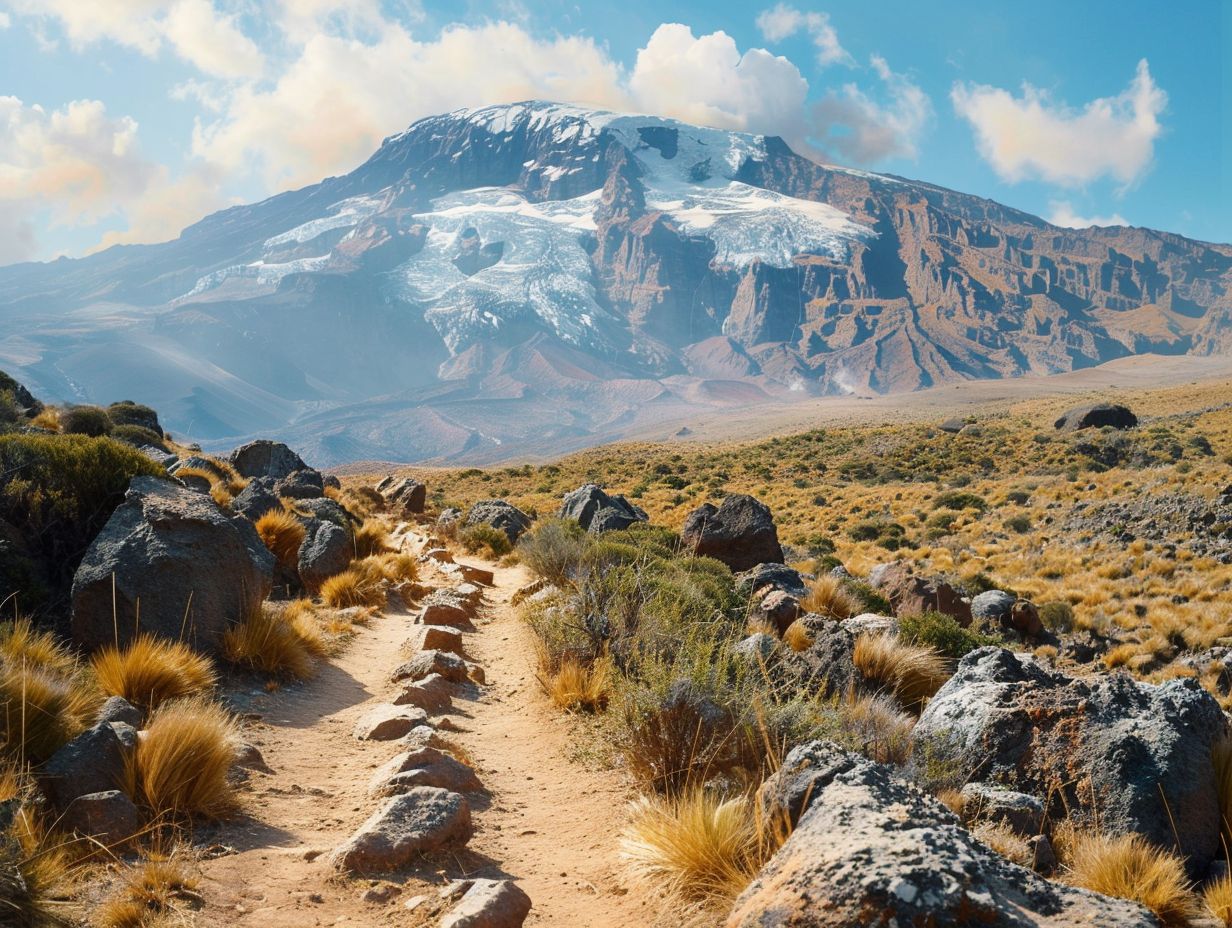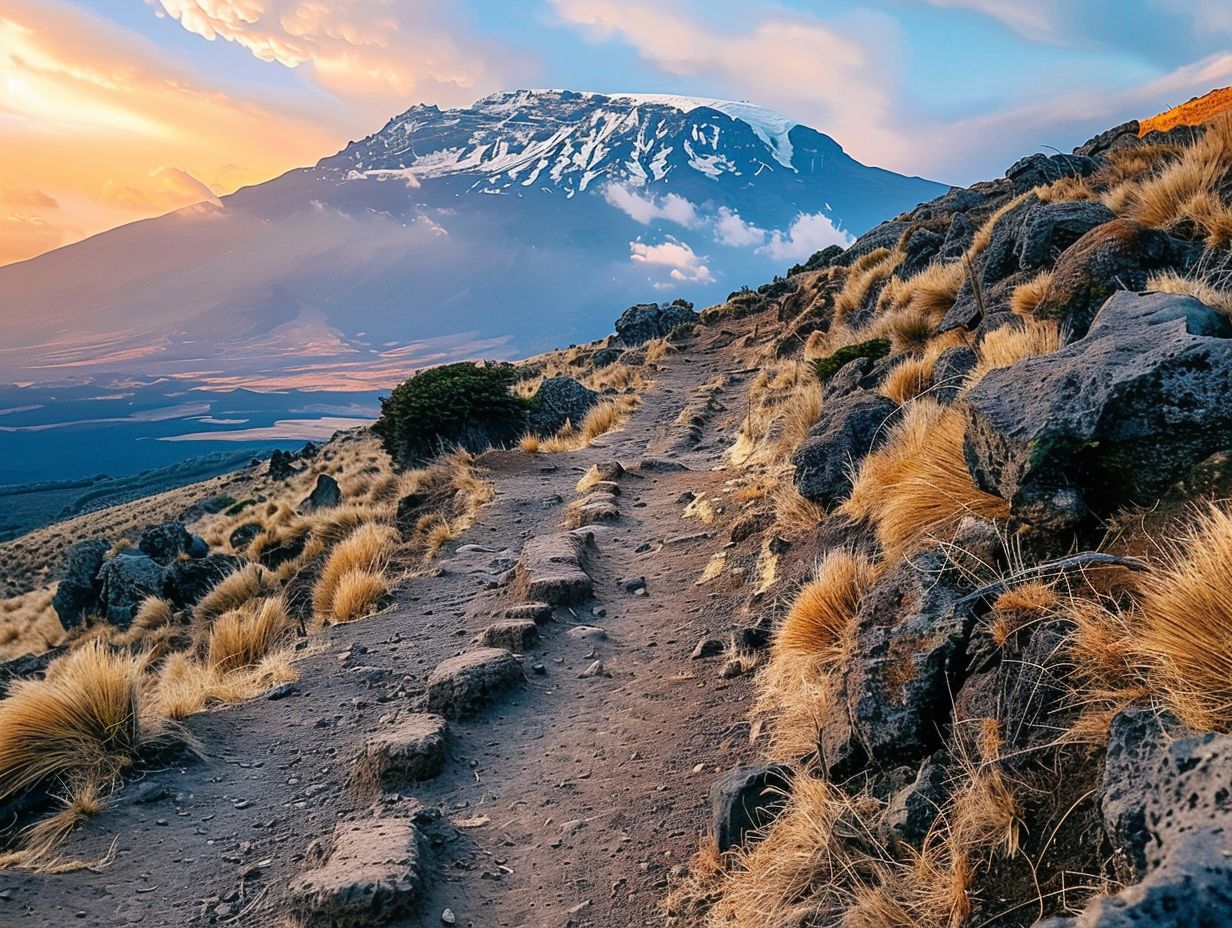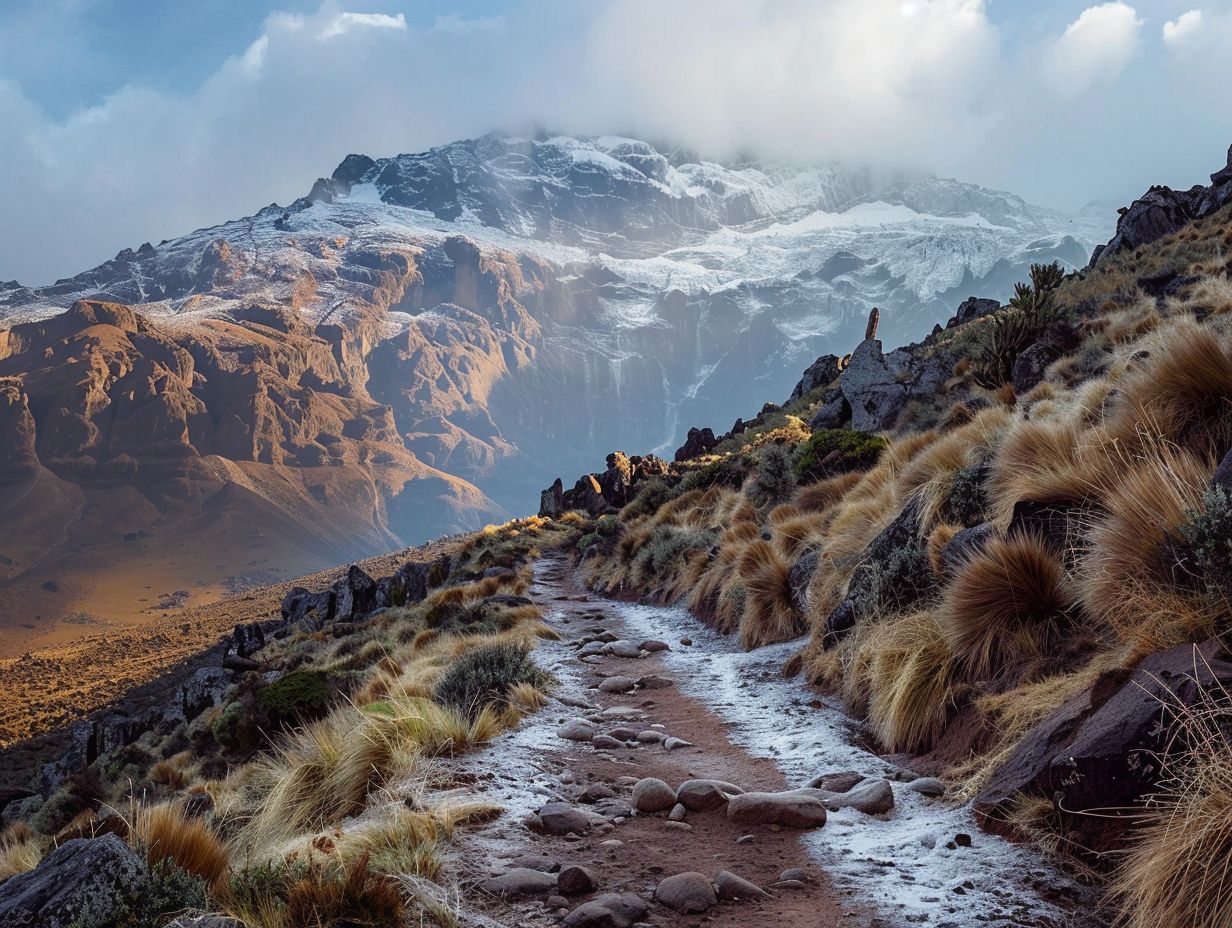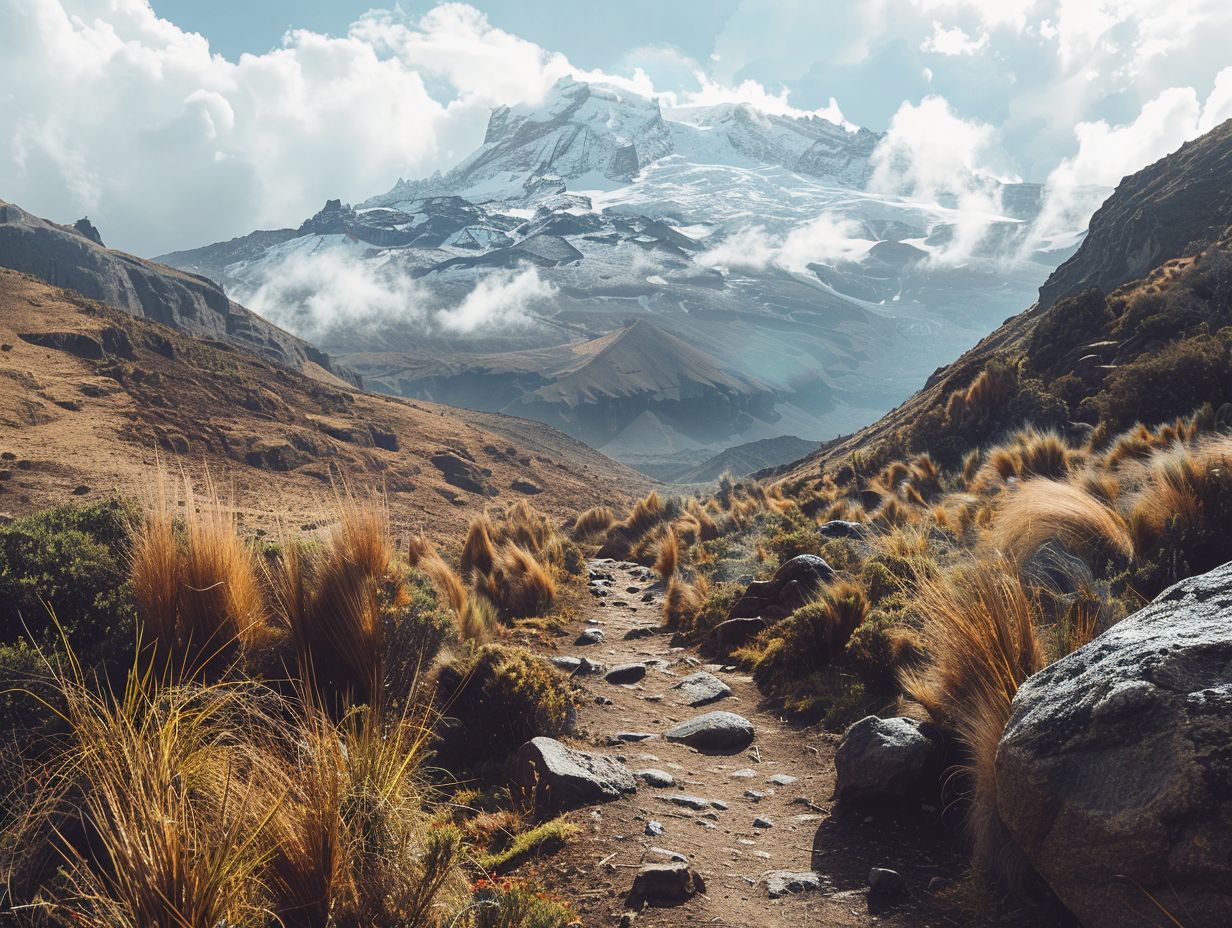
If you’re considering climbing Kilimanjaro, you may have come across the Umbwe Route. But what exactly is the Umbwe Route and why should you choose it for your trek?
In this article, we’ll explore the features that make the Umbwe Route unique, the challenges you may face along the way, the highlights of the route, as well as tips for a successful hike.
Whether you’re a seasoned hiker or a beginner looking for an adventure, this guide will help you prepare for the ultimate Kilimanjaro experience.
Key Takeaways:

- The Umbwe Route offers a challenging and less crowded alternative to reach the summit of Kilimanjaro.
- Proper preparation, including packing appropriate clothing and gear, is crucial for a successful hike on the Umbwe Route.
- The Umbwe Route provides stunning views, unique flora and fauna, and the opportunity to summit via Stella Point.
What is the Umbwe Route?
The Umbwe Route is a challenging and less crowded trail leading trekkers to the summit of Kilimanjaro, the tallest mountain in Africa. It is known for its steep and difficult terrain, offering a unique and rigorous climbing experience.
Unlike the more popular routes like Marangu or Machame, the Umbwe Route is considered one of the toughest ways to ascend Kilimanjaro due to its steep ascents and limited time for acclimatization. The trail is characterized by dense forest sections, rocky paths, and stunning views of the surrounding landscapes.
Climbers often appreciate the solitude and raw beauty this route offers, making it a favorite among seasoned adventurers seeking a more challenging and less-crowded experience. The Umbwe Route may not be for beginners, but for those looking to test their limits and conquer Kilimanjaro in a more rugged manner, it holds a special allure.
Why Choose the Umbwe Route?
Choosing the Umbwe Route for your Kilimanjaro expedition offers a more challenging experience with a higher level of difficulty, making it ideal for experienced trekkers seeking an adventure. Despite its demanding nature, successful summit attempts on the Umbwe Route provide a great sense of accomplishment.
The Umbwe Route stands out among the numerous routes up Mount Kilimanjaro for its steep inclines and shorter duration, attracting thrill-seekers and those looking to push their limits. Its direct ascent and the lack of time for acclimatization pose a significant challenge, but those who conquer it are greeted with unparalleled satisfaction at the summit.
While the Umbwe Route may have a lower success rate compared to some other routes due to its demanding nature, the feeling of achievement upon reaching Uhuru Peak is incomparable. The sheer determination and physical effort required to tackle this route make every step towards the summit immensely rewarding.
What Makes the Umbwe Route Challenging?
The Umbwe Route presents various challenges due to its rapid altitude gain, steep inclines, and difficult hiking conditions. Trekkers need to be prepared for strenuous ascents, rocky terrain, and minimal time for acclimatization.
The ascent on the Umbwe Route is exceptionally demanding, as it involves navigating through high-altitude zones where oxygen levels are lower, making it physically taxing for even the most experienced hikers. The steep paths and rugged terrain test the endurance and agility of trekkers, requiring constant focus and balance.
The route’s quick elevation gain poses a significant challenge for acclimatization, increasing the risk of altitude sickness and requiring trekkers to be well-prepared both physically and mentally to tackle the difficult conditions they will face.
How Long is the Umbwe Route?
The Umbwe Route typically takes 6 to 7 days to complete, covering around 50 miles of trekking distance. This duration allows trekkers to acclimatize gradually and enjoy the scenic beauty along the way.
During these 6 to 7 days of trekking on the Umbwe Route, adventurers get the opportunity to immerse themselves in the rugged beauty of the Kilimanjaro region. With an average daily distance of approximately 7-8 miles, hikers can savor every step while gradually ascending to higher altitudes.
The journey not only tests physical endurance but also offers mesmerizing panoramas of diverse landscapes, from lush forests to alpine meadows. This careful pace of the trek aids in proper acclimatization, vital for a successful summit attempt.
What is the Success Rate of the Umbwe Route?
The success rate of summiting Kilimanjaro via the Umbwe Route is lower compared to other routes due to its challenging nature. Trekkers who are well-prepared and acclimatized have a good chance of reaching the summit.
One of the key factors influencing summit success on the Umbwe Route is the steep and direct ascent it offers, which can be physically demanding. This route is known for its rapid altitude gain, making it crucial for climbers to be adequately acclimatized to reduce the risk of altitude-related illnesses.
Proper preparation, both physically and mentally, plays a vital role in determining the outcome of this trek. Trekkers should focus on building endurance and strength through regular exercise and hiking practice, especially on challenging terrains.
What is the Best Time to Hike the Umbwe Route?

The best time to hike the Umbwe Route is during the dry seasons of January to March and June to October when the weather is more stable, offering clear skies and better climbing conditions.
During these periods, the likelihood of encountering rain and mist is significantly reduced, enhancing the overall hiking experience. The dry seasons not only provide favorable weather conditions but also allow for better visibility of the stunning landscapes along the route.
The cooler temperatures during these months make the climb more manageable and enjoyable, as opposed to the hotter and more challenging conditions experienced in the wet season. Choosing to embark on the Umbwe Route during these optimal periods increases the chances of a successful and memorable adventure.
What are the Highlights of the Umbwe Route?
The Umbwe Route boasts several highlights, including breathtaking scenic views, unique flora and fauna sightings, uncrowded trails, and the opportunity to summit Kilimanjaro via Stella Point.
The spectacular scenery along the Umbwe Route is unmatched, offering panoramic vistas of lush forests, rugged terrain, and distant horizons that leave hikers in awe.
As you ascend through the route, you’ll encounter a rich variety of plant life, from vibrant wildflowers to towering trees, creating a botanical paradise unlike any other.
What sets this route apart is the tranquility it offers, with fewer trekkers compared to other popular paths, allowing you to fully immerse yourself in nature and savor the peaceful surroundings.
Scenic Views
The Umbwe Route offers trekkers spectacular scenic views of Kilimanjaro’s majestic slopes, rugged terrain, and distant horizons, providing an unparalleled mountain experience.
As climbers ascend along the route, they are greeted by an ever-changing panorama of lush rainforests, alpine meadows, and rocky outcrops. The scenery is not only diverse but also awe-inspiring, with every step revealing new facets of Kilimanjaro’s natural beauty.
From vantage points along the trail, adventurers can marvel at the vast expanse of the mountain’s snow-capped peaks, surrounded by a sea of clouds below. This extraordinary view from high altitude is a reminder of the sheer magnificence of nature and is bound to leave an indelible mark on any trekker’s memory.
Unique Flora and Fauna
The Umbwe Route is rich in unique flora and fauna, showcasing rare plant species, vibrant foliage, and occasional wildlife sightings, adding an element of adventure to the trek.
Trekkers traversing the Umbwe Route are greeted by a tapestry of plant life, ranging from colorful orchids to towering tree ferns, creating a botanical paradise. The trail leads through lush montane forests, where endemic species like the Kilimanjaro Violet and giant lobelias thrive in the cool, misty climate.
As the trek progresses, hikers may spot wildlife such as colobus monkeys swinging through the canopy or elusive bushbucks grazing in the undergrowth. The encounters with these creatures amidst the stunning landscape of the route make the journey truly memorable.
Less Crowded
One of the advantages of the Umbwe Route is its low foot traffic, offering trekkers a sense of solitude and tranquility amidst the raw beauty of Kilimanjaro’s remote trails.
The peaceful and less crowded nature of the Umbwe Route allows hikers to immerse themselves in the untouched wilderness, far away from the hustle and bustle of busier trails. This trail, known for its rugged terrain and challenging paths, provides a unique experience for those seeking a more intimate connection with nature.
Tranquility envelops trekkers as they traverse through the dense forests, making the journey not just physically demanding but also spiritually rewarding.
Summiting via Stella Point
Reaching the summit of Kilimanjaro via Stella Point on the Umbwe Route is a challenging yet rewarding achievement, offering trekkers stunning views and a unique sense of accomplishment.
Choosing the Umbwe Route to reach Stella Point presents adventurers with an arduous trek, characterized by steep ascents through the dense rainforest and challenging terrain.
The physical demands and mental resilience required are handsomely rewarded with breathtaking panoramas as you ascend higher, eventually culminating in the triumphant moment at the summit of the highest peak in Africa. The sense of achievement and awe as you stand at this remarkable point is unparalleled, making every step of the journey worth the effort.
What is the Itinerary for the Umbwe Route?

The Umbwe Route itinerary typically includes multiple camps such as Barranco Camp and Barafu Camp, with specific daily hiking schedules and designated resting points to ensure trekkers acclimatize properly and enjoy the journey.
On the first day of the trek, hikers usually begin from Umbwe Gate and hike through lush rainforest to the Umbwe Camp, which serves as the initial campsite. The second day involves a steep ascent to the infamous Barranco Camp with panoramic views along the route.
Acclimatisation often integrated into the itinerary at Barranco Camp, allowing trekkers to adjust to the altitude. The subsequent day typically includes a challenging hike to Karanga Camp, a crucial acclimatization stop before pushing towards the summit.
- Day 4 typically involves a short hike to Barafu Camp, the base for the summit attempt. This strategic high camp offers trekkers the chance to rest and prepare for the final ascent.
- The summit day, often starting in the early hours, sees trekkers traveling to Uhuru Peak and descending back to Mweka Camp for a well-deserved rest after the grueling challenge. The final day usually leads to Mweka Gate, marking the end of this exhilarating adventure.
What to Pack for the Umbwe Route?
Packing essentials for the Umbwe Route trek includes proper clothing and gear for varying weather conditions, sufficient snacks and water for energy replenishment, and essential documents like permits and identification for a hassle-free journey.
In terms of clothing, it is important to have layered options to accommodate the unpredictable weather on the mountain. This includes moisture-wicking base layers, insulating mid-layers, and a waterproof outer shell. Don’t forget to pack sturdy hiking boots with good ankle support for the challenging terrain.
As for gear, make sure to have a durable backpack to comfortably carry your essentials. Include a warm sleeping bag suitable for low temperatures, a headlamp for early morning starts or late arrivals at campsites, and trekking poles for added stability.
When packing snacks, opt for high-energy options like nuts, dried fruits, and energy bars. Hydration is crucial, so carry a hydration bladder or water bottles and consider packing water purification tablets for refills along the way.
Ensure you have valid permits, a copy of your passport, and any other required documentation to avoid any issues during your trek.
Proper Clothing and Gear
Selecting appropriate clothing and gear for the Umbwe Route is crucial to ensure comfort, protection, and safety during the trek. Items like insulated jackets, sturdy boots, and moisture-wicking layers are essential for varying weather conditions.
Since the Umbwe Route is known for its steep and challenging terrain, it is advisable to pack durable trekking pants and gaiters to protect against abrasions and thorns. Having a reliable waterproof jacket and pants will shield you from unexpected rain showers or cold winds at higher altitudes.
Don’t forget to pack a warm hat, gloves, and a buff to keep you cozy during chilly mornings and nights. Sunglasses and sunscreen are essential for protection against the harsh UV rays, especially in the open sections with intense sun exposure.
Essential Documents
Carrying essential documents such as trekking permits, identification cards, and medical paperwork is vital for compliance with regulations and for emergency identification and assistance during the Umbwe Route expedition.
Having the necessary documents ensures that trekkers are legally authorized to be on the route and helps park authorities to monitor and safeguard all personnel efficiently and maintain safety standards.
Permits play a crucial role in trekking, regulating the number of climbers to prevent overcrowding and preserve the environment. Identification cards are essential for verifying individuals’ identities, while medical records enable swift and accurate treatment if any health issues arise during the challenging journey. It’s imperative to keep these documents secure, easily accessible, and valid for the entire duration of the expedition.
Snacks and Water
Carrying adequate snacks and water supplies is essential for maintaining energy levels, hydration, and overall well-being throughout the rigorous trek on the Umbwe Route. Portable snacks and hydration systems are recommended for convenience.
It is essential to choose snacks that are lightweight, non-perishable, and high in energy, such as nuts, trail mix, granola bars, and dried fruits.
Plus snacks, a substantial amount of water or electrolyte-rich drinks should be carried to prevent dehydration, especially in the high-altitude conditions along the route.
Hydration systems like Camelbak or reusable water bottles are practical options to ensure easy access to hydration throughout the trek.
What is the Cost of the Umbwe Route?
The cost of the Umbwe Route trek varies depending on the tour operator, services included, and duration of the expedition. While the route can be more expensive due to its challenging nature, choosing reputable trek operators ensures a safe and well-organized experience.
When considering the cost factors, it’s essential to account for expenses such as park fees, camping equipment, porters, and guides. These costs can add up, especially for solo trekkers or small groups. Trek operators play a crucial role in managing these expenses efficiently by providing transparent pricing, inclusive packages, and expert guidance.
They handle logistics like transportation, permits, meals, and accommodations, making the trek experience hassle-free. By partnering with experienced operators, trekkers can enjoy the journey without worrying about the intricacies of planning and coordination.
Tips for a Successful Hike on the Umbwe Route

To ensure a successful hike on the Umbwe Route, it is essential to focus on gradual acclimatization, proper gear selection for rocky terrain, pacing yourself, staying hydrated, and following the guidance of experienced guides throughout the trek.
Acclimatization is vital as it helps your body adjust to the altitude and reduces the risk of altitude sickness. It is advisable to spend an extra day at Barranco Camp for this purpose.
When tackling the rocky terrain along the route, ensure your footwear provides proper ankle support and traction to navigate the challenging surfaces efficiently.
Hydration is key in preventing altitude-related issues, so drink plenty of water throughout the trek. Carrying a water purification system can be handy.
Local guides are invaluable resources, offering insights into the route, sharing local knowledge, and ensuring your safety every step of the way.
Conclusion
The Umbwe Route on Kilimanjaro offers a challenging yet rewarding trekking experience, testing the limits of adventurers with its steep trails, high altitude, and breathtaking views. Successfully summiting via the Umbwe Route is a remarkable achievement that showcases perseverance and determination.
Beginning the journey on the Umbwe Route, trekkers are immediately exposed to the rugged terrain characterizing this less-traveled path. The initial steep inclines and dense vegetation immerse hikers in a wild environment, setting the tone for the demanding ascent ahead.
As climbers navigate through the trail, the sense of isolation and raw natural beauty envelops them, making each step a test of physical and mental strength.
The experience of conquering high altitudes brings its own set of challenges, from acclimatization issues to navigating rocky passages. The reward of reaching the summit is unparalleled, offering panoramic views that extend over the vast landscapes below, creating a moment of pure triumph and awe.
In the face of these adversities, those who persevere and push past their limits are met with a sense of accomplishment like no other. The journey along the Umbwe Route culminates in not just reaching the summit but in proving one’s resilience and determination.
Success on this challenging path is not just about reaching the peak of Kilimanjaro but about conquering personal barriers, forging memories that last a lifetime, and gaining a deeper appreciation for the strength within oneself.
Frequently Asked Questions
What is the Umbwe Route on Kilimanjaro?
The Umbwe Route is one of the seven main routes to climb Mount Kilimanjaro, the highest peak in Africa. It is known for its challenging and scenic path, as it takes climbers through thick forests and steep terrain.
Why should I choose the Umbwe Route for my Kilimanjaro climb?
The Umbwe Route offers a unique and less crowded experience compared to other routes on Kilimanjaro. It is also known for its stunning views and diverse landscapes, making for a memorable and rewarding journey.
How long is the Umbwe Route on Kilimanjaro?
The Umbwe Route is approximately 53 kilometers long and can be completed in 6-7 days. However, it is recommended to take an extra day for acclimatization to increase your chances of reaching the summit.
Is the Umbwe Route on Kilimanjaro suitable for beginners?
The Umbwe Route is a challenging climb and is not recommended for beginners. It requires a high level of physical fitness, as well as prior experience with multi-day hikes and high-altitude trekking.
Are there any altitude-related risks on the Umbwe Route on Kilimanjaro?
As with any climb on Kilimanjaro, there is a risk of altitude sickness on the Umbwe Route. It is important to properly acclimatize and listen to your guide’s instructions to minimize these risks.
How do I prepare for the Umbwe Route on Kilimanjaro?
To prepare for the Umbwe Route, it is recommended to engage in regular physical exercise and train for high-altitude trekking. It is also important to pack the necessary gear and equipment as advised by your tour operator.